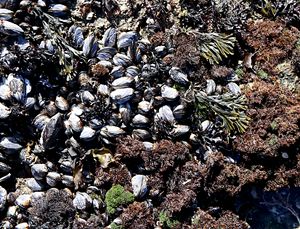Posted on KQED News Blog: September 26, 2012 — By Lauren Sommer

Marine scientists from around the world are gathering in Monterey this week to discuss what is sometimes a little-noticed climate change problem: ocean acidification.
The oceans have become about 30 percent more acidic since the start of the Industrial Revolution – the result of soaking up carbon dioxide from the atmosphere. Today, oceans absorb about a million tons of carbon an hour.
Scientists are projecting even larger changes over the next century – potentially double today’s acidity. So the big question in the field is: can marine life adapt?
The Problem
Changing pH levels are trouble for animals with shells. That’s because they use molecules in the water – carbonate ions – to make those shells. As water becomes more acidic, there’s less carbonate for organisms to use.
In studies of mussels, oysters and urchins, scientists see similar effects when they’re grown in more acidic water: slower growth and weaker shells. They’re particularly sensitive when they’re young larvae.
It’s already a concern for the West Coast shellfish industry, but scientists say ocean acidification could affect the entire food web. Some organisms at the base of the food chain are at risk, like pteropods, a small marine snail that’s a food source for young salmon. Coral reefs are also a big concern. They build their slow-growing skeletons with the same material in seawater.
Winners and Losers
It’s not all bad news. In some cases, marine organisms may benefit from more acidity. David Hutchins, a professor of Biological Sciences at the University of Southern California, has been studying phytoplankton, the tiny organisms at the bottom of the food chain. “We don’t have fish, we don’t have whales, we don’t have anything else without them,” he says.
One group of phytoplankton plays a big role in the marine food web by processing nitrogen from the atmosphere (an ingredient essential for life). Hutchins says these phytoplankton could be winners in a more acidic future. In studies, they do better and produce more nitrogen for the entire food web.
On the flip side, though, are phytoplankton that cause major problems off the West Coast – the harmful algal blooms known as red tides. These phytoplankton produce a toxin called domoic acid that accumulates in the food chain. Algal blooms have shut down the shellfish industry and sickened sea lions, who often show up on Northern California beaches with seizures.
In more acidic water, “our research suggests many of these red tide organisms are producing more toxins,” says Hutchins, potentially creating more harmful blooms. “A problem that does $100 million dollars a year in damage today may get worse in the future.”
Studying Adaptation
While marine life has adapted to changing acidity in the past, scientists say it’s the unprecedented rate of change today that’s the concern. Organisms may not be able to evolve fast enough.
The unique ocean conditions off the West Coast could give scientists a window into how that happens. Marine life here is blasted with acidic water every year through seasonal upwelling. It happens when wind patterns in the spring and summer drive surface water offshore, drawing acidic water up from the deep.
A collaborative group of scientists is using this naturally occurring experiment to see if marine life here has adapted. They’re studying California mussels and purple sea urchins from up and down the coast to see if they’ve developed genetic adaptations that help them in more acidic water. (Check out this KQED Science feature story for more).
Scientists at this week’s Third International Symposium on the Ocean in a High-CO2 World are still sorting out these questions, made even more complicated by raising temperatures and existing problems like pollution and overfishing.
Policymakers are just starting to grapple with ocean acidification. Washington State has convened a blue ribbon panel that will make recommendations on both science and policy. But the global scope of the problem will be a challenge.
“You can’t put a shield over certain ecosystems to protect them,” says UC Santa Cruz scientist Greg Rau, who is pushing marine scientists to study more hands-on options. “Could we do some genetic engineering? Could we do some selective breeding that would sort of speed up the evolutionary process that would allow at least some organisms to survive?” Rau says.
Learn more about a ocean acidification in this audio report from KQED Science: